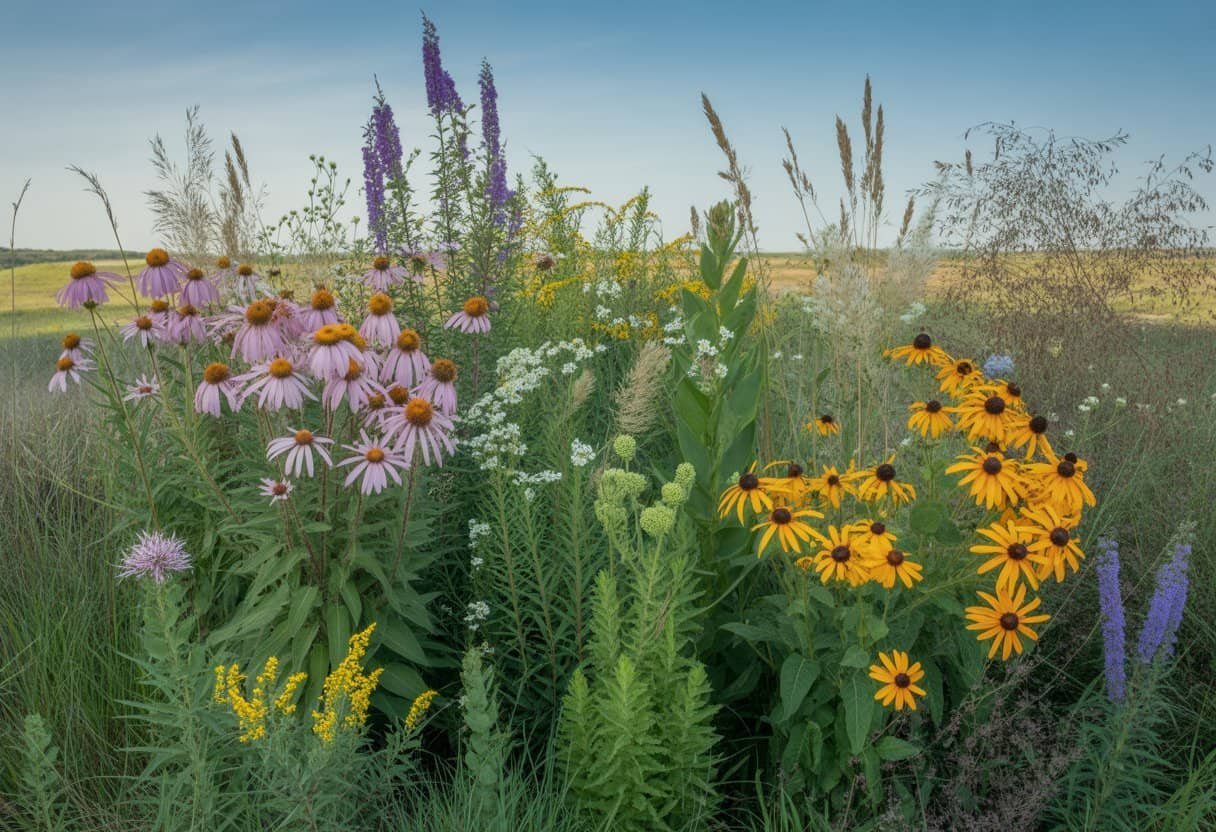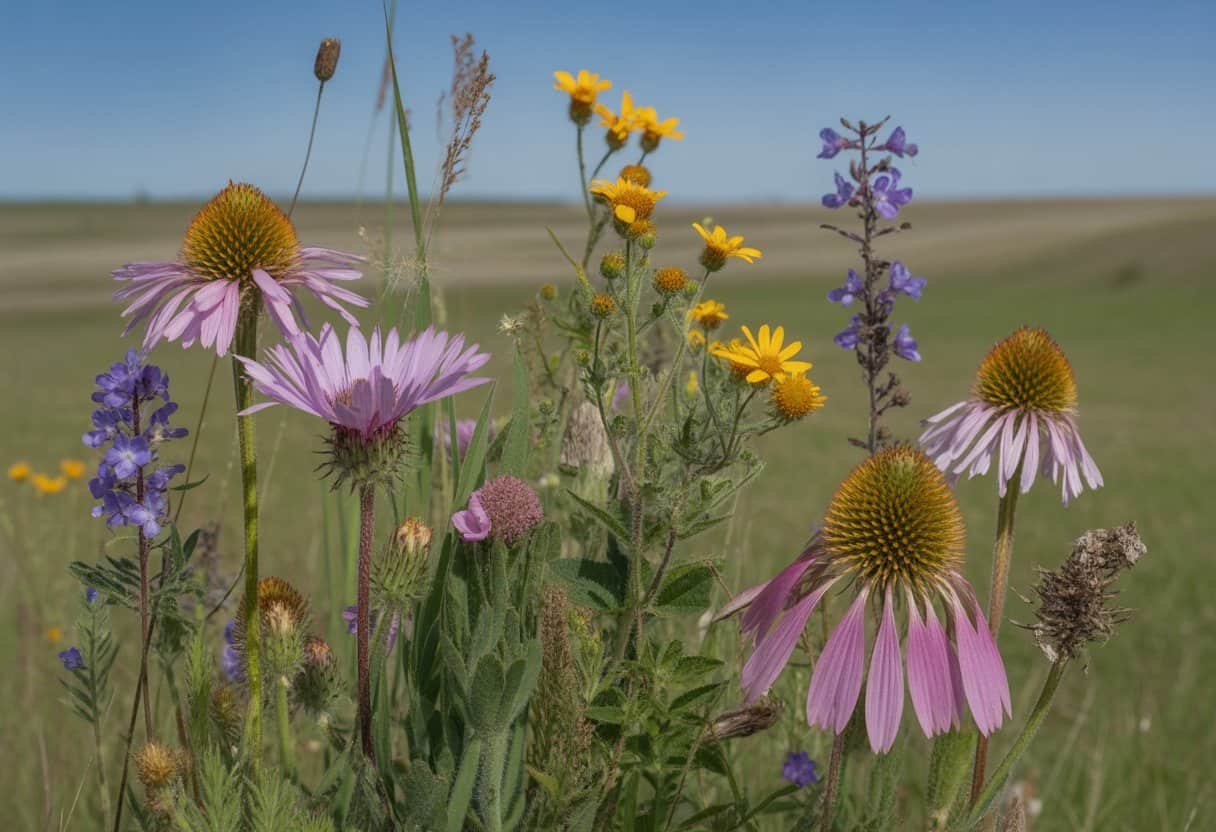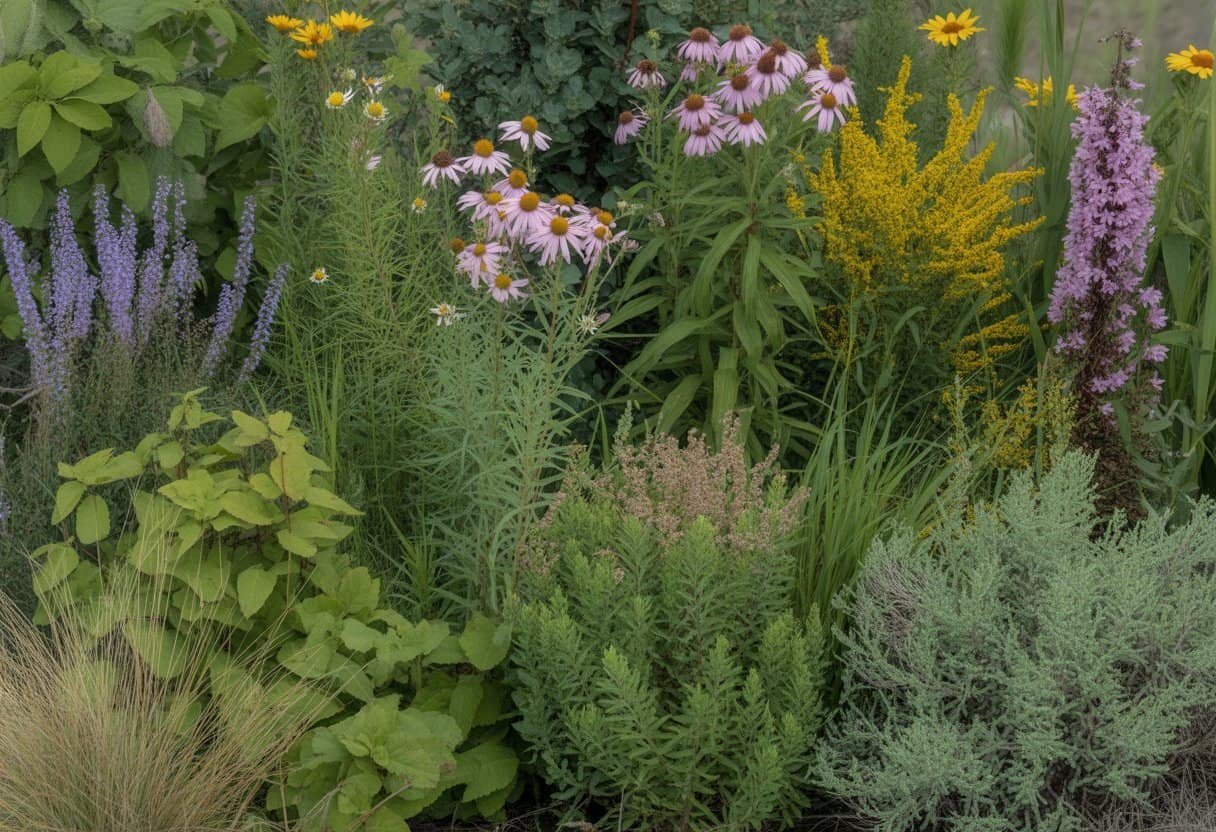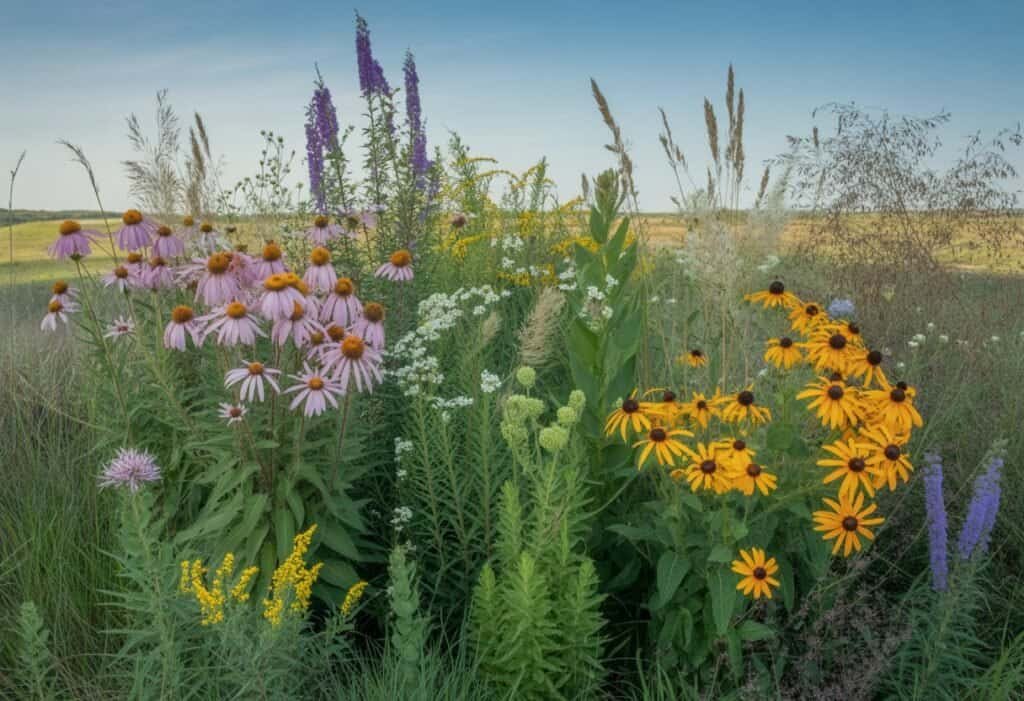Kansas native plants have adapted to the unique climate and soil conditions of the state over thousands of years. These resilient species thrive in the prairie landscape and require less water and maintenance than non-native alternatives.
They include a diverse range of grasses, wildflowers, trees, and shrubs that are perfectly suited to Kansas conditions.

Growing native plants in your Kansas garden supports local ecosystems and creates habitat for beneficial wildlife like butterflies, bees, and birds. Prairie plants have deep root systems that help prevent soil erosion and improve water quality by filtering runoff.
They also provide beautiful, seasonal displays of color throughout the year.
Kansas natives come in many varieties, from the iconic sunflower to treasures like prairie blazing star and butterfly milkweed. These plants connect us to our natural heritage and offer practical benefits for modern landscapes.
Key Takeaways
- Kansas native plants need less water and maintenance while thriving in local soil and climate.
- Native plant gardens support wildlife and ecosystems and help prevent erosion and improve water quality.
- From sunflowers to prairie grasses, Kansas natives offer seasonal beauty and preserve the state’s natural heritage.
Defining Kansas Native Plants

Kansas native plants have evolved in the region over thousands of years. They adapted to local soil, rainfall, and weather extremes.
These plants form the foundation of Kansas ecosystems. They provide benefits for wildlife and sustainable landscaping.
What Are Native Plants?
Native plants are species that have grown naturally in a region without human introduction. In Kansas, native plants developed here long before European settlement.
These plants adapted to Kansas’s unique climate, including hot summers, cold winters, and varying rainfall.
The Kansas landscape features several distinct ecosystems. The eastern part receives more rainfall and supported tallgrass prairies.
Central Kansas was home to mixed-grass prairie. The western region featured shortgrass prairie adapted to drier conditions.
Native Kansas plants include big bluestem, purple coneflower, and butterfly milkweed. These plants evolved alongside local wildlife, creating interdependent relationships over centuries.
Distinguishing Native, Non-Native, and Invasive Species
Native plants occur naturally in Kansas ecosystems without human introduction. They evolved here over thousands of years and support local wildlife.
Non-native plants come from other regions or countries. Many were brought for gardens, agriculture, or by accident.
Some non-natives coexist peacefully with native plants. Others do not cause harm.
Invasive species are usually non-native plants that spread aggressively. They outcompete native plants for resources like light, water, and nutrients.
Common Kansas invasives include musk thistle, kudzu, and Bradford pear trees. Not all non-natives become invasive.
Invasive plants can dramatically alter ecosystems, reduce biodiversity, and eliminate food sources for wildlife.
Ecological Benefits of Native Species
Native plants provide essential habitat for Kansas wildlife. Birds, butterflies, and bees rely on native plants for food and shelter.
Monarch butterflies specifically need milkweed to reproduce. These plants support healthy soil systems with their deep root networks.
Prairie grasses can develop roots extending 15 feet deep. These roots prevent erosion and improve soil quality.
Native plants need less maintenance once established. They typically use less water, fertilizer, and pesticides than non-native ornamentals.
This makes them cost-effective and environmentally friendly choices for landscapes. Kansas native plants also help manage stormwater by absorbing rainfall better than turf grass.
Their ability to thrive in local conditions makes them resilient during droughts and extreme weather.
Major Groups of Kansas Native Plants

Kansas landscapes feature diverse plant communities adapted to the state’s climate and soil. Native plants fall into several major categories based on their growth habits and characteristics.
Woody Plants and Trees
Kansas hosts a variety of native trees and shrubs that provide wildlife habitat and protect soil from erosion. In eastern Kansas, oak species dominate, including bur oak, chinkapin oak, and red oak.
These trees can live for centuries and support hundreds of insect species. Hackberry, American elm, and cottonwood trees thrive along waterways.
The cottonwood, Kansas’s state tree, can grow over 100 feet tall with its fluttering leaves. Native shrubs include fragrant sumac, American plum, and elderberry.
These woody plants produce berries that feed birds and wildlife. Roughleaf dogwood forms thickets in woodland edges.
Prairie shrubs like leadplant and New Jersey tea have deep roots that help them survive drought and fire.
Grasses and Sedges
Grasses form the backbone of Kansas prairies. Big bluestem, often called “turkey foot” for its seed head, can reach heights of 6-8 feet and once dominated much of the state.
Little bluestem creates reddish-copper fall color and thrives in drier sites. Other important native grasses include switchgrass, indiangrass, and sideoats grama, the state grass of Kansas.
Sedges complement grasses in wetter areas. Fox sedge, palm sedge, and prairie sedge help filter water in rain gardens and wetlands.
Unlike grasses, sedges have triangular stems (“sedges have edges”). They remain green earlier in spring and later into fall than most grasses.
Flowering Plants and Forbs
Colorful wildflowers, or forbs, add seasonal beauty to Kansas landscapes. Purple coneflower draws butterflies with its spiky center cone and drooping petals.
Black-eyed Susan’s bright yellow flowers bloom from June through September. Spring brings delicate blooms like wild columbine and prairie phlox.
Summer showcases bee balm, butterfly milkweed, and compass plant with its massive yellow flowers. Fall prairie displays include goldenrod, asters, and blazing stars.
These deep-rooted plants support pollinators and resist drought once established. Many native forbs served as traditional medicines for indigenous peoples, including echinacea and wild bergamot.
Iconic Kansas Wildflowers and Rare Species
Kansas prairies showcase a remarkable diversity of native flowering plants. These species have adapted to the state’s unique climate and soils.
From the familiar state flower to endangered species found nowhere else, these plants represent Kansas’s natural heritage.
Recognized Kansas Wildflowers
The sunflower (Helianthus annuus) stands as Kansas’s official state flower. Its bright yellow petals and dark center make it instantly recognizable across the landscape.
These hardy plants can grow up to 10 feet tall and track the sun’s movement throughout the day. Purple coneflower (Echinacea purpurea) thrives in Kansas prairies with distinctive drooping purple petals around a spiky orange-brown center.
Native Americans and early settlers valued this plant for its medicinal properties. Butterfly milkweed (Asclepias tuberosa) displays vibrant orange flowers that attract pollinators, especially monarch butterflies.
This drought-resistant perennial grows naturally in dry, rocky soils throughout Kansas. Wild indigo (Baptisia australis) produces showy blue-purple flowers in spring, followed by inflated seed pods that turn black when mature.
These robust plants develop deep taproots, helping them survive harsh prairie conditions.
Unique and Rare Native Species
Western prairie fringed orchid is one of Kansas’s most endangered plants. It has delicate white flowers with fringed petals and requires specific prairie habitats.
Mead’s milkweed exists only in a few tallgrass prairie remnants. Its pale green flowers bloom in early summer, but this species has become critically endangered as prairies have been converted to farmland.
Buffalo gourd (Cucurbita foetidissima) spreads across sandy soils in western Kansas. This hardy vine produces yellow flowers and small, bitter gourds.
Native peoples used parts of this plant for tools, soap, and medicine. Bloodroot (Sanguinaria canadensis) grows in eastern Kansas woodlands.
This spring ephemeral produces white flowers that emerge before the distinctive lobed leaves unfold. The plant contains a red sap that Indigenous people used as dye.
Seasonal Blooms and Sunlight Needs
Kansas wildflowers follow distinct blooming seasons. Spring species like spiderwort (Tradescantia ohiensis) open in morning sunlight but close by afternoon to conserve moisture.
Summer brings black-eyed Susans and prairie clovers that thrive in full sun (6+ hours daily). These plants have special adaptations to withstand intense summer heat and limited rainfall.
Full-sun wildflowers include:
- Blanketflower (Gaillardia)
- Prairie blazing star (Liatris)
- Wild hollyhock (Illiamna remota)
Partial-shade species flourish in woodland edges:
- Wild columbine (3-6 hours sunlight)
- Solomon’s seal (dappled morning light)
- Wild geranium (filtered sunlight)
Fall-blooming asters and goldenrods provide late-season nectar for pollinators preparing for winter. These plants usually need moderate sunlight and can tolerate drier conditions than spring bloomers.
Kansas Native Plant Identification
Learning to identify Kansas native plants helps gardeners, hikers, and conservationists understand and protect local ecosystems. Proper identification allows you to select the right plants for your garden and distinguish beneficial natives from invasive species.
Tools and Techniques for Plant ID
Several tools help with Kansas native plant identification. Field guides specific to the Great Plains region offer detailed information about local species.
The “Kansas Wildflowers and Grasses” website provides an extensive database of native plants with search functions based on colors and bloom times. Plant identification apps like iNaturalist and PlantNet let you take photos and receive instant suggestions.
These apps use image recognition to match your photos with their databases. When identifying plants in the field, examine these features:
- Leaf arrangement (alternate, opposite, whorled)
- Flower structure and color
- Plant height and growth habit
- Stem characteristics (square, round, hairy)
- Habitat where the plant is growing
Local extension offices also offer identification services for plants you cannot identify yourself.
Using Identification Photos
Clear photographs improve plant identification accuracy. When taking photos, capture multiple parts of the plant including flowers, leaves, stems, and the entire growth habit.
For flower photos, show both the front and side views. This reveals important structural details.
Take close-up shots of leaf attachments to stems, as this feature often distinguishes between similar species. Include something for scale, like a coin or ruler.
Seasonal photos are valuable since plants change appearance throughout the year. A prairie blazing star looks very different in spring versus its summer flowering period.
Photo lighting tips:
- Avoid harsh midday sun that creates shadows
- Cloudy days provide even lighting
- Early morning or late afternoon light shows textures best
Differentiating Weeds from Natives
Many Kansas weeds resemble native plants, so proper identification is crucial. Native plants usually have deeper root systems and need less water once established compared to common weeds.
Jimsonweed, a toxic non-native plant, is often confused with native nightshades. Identify jimsonweed by its large white trumpet-shaped flowers and spiny seed pods.
This dangerous plant should not be handled without gloves. Some weeds were introduced and have escaped cultivation.
These include musk thistle and Bradford pear trees, which outcompete native plants for resources. Native plant alternatives often provide better wildlife habitat.
For example, instead of invasive bush honeysuckle, plant native elderberry or American beautyberry. Not all “weedy-looking” plants are harmful.
Some natives like milkweed species may appear unruly but provide essential habitat for monarch butterflies and other pollinators.
Planting and Managing Native Plants in Kansas Landscapes
Kansas native plants thrive in local landscapes when you select and maintain them properly. These plants have adapted to our climate and soil conditions over thousands of years.
They make ideal choices for sustainable gardens.
Evaluating Your Property
Start by assessing your property’s unique characteristics. Perform a simple soil test to determine if your soil is clay, loam, or sandy.
Kansas State Extension offices offer these tests. Check drainage patterns after rainfall.
Areas where water pools need moisture-loving natives. Quick-draining spots suit drought-tolerant species.
Consider the topography and existing features. Slopes benefit from erosion-controlling plants with strong roots.
Flat areas offer more flexibility for plant selection. Map out underground utilities before digging.
Call 811 at least two days before any planting project to have lines marked for free. Document seasonal changes across your property.
This helps you identify microclimates that might support different native plant communities.
Selecting Site Conditions: Shade and Sun
Sun exposure significantly impacts plant success. Full sun areas (6+ hours of direct sunlight) support prairie species like coneflowers, black-eyed Susans, and little bluestem grass.
Partial shade locations (3-6 hours of sun) work well for adaptable natives such as:
- Solomon’s seal
- Wild ginger
- Columbine
- Woodland phlox
Deep shade areas need specialized woodland natives. These include ferns, sedges, and spring ephemerals that finish their life cycle before tree canopies fully leaf out.
Monitor seasonal sun patterns. Winter sun reaches different areas than summer sun because of the sun’s changing angle.
Consider how buildings, fences, and existing trees create shade that shifts throughout the day.
Successful Establishment and Maintenance
Proper planting techniques ensure long-term success. Plant during spring or fall when temperatures are moderate and rainfall is more reliable.
Dig holes twice as wide as the root ball but at the same depth. Water newly planted natives regularly for the first year.
Most require 1-2 inches of water weekly during establishment, including rainfall. After the first year, many natives thrive with minimal supplemental water.
Apply 2-3 inches of organic mulch to suppress weeds and retain moisture. Keep mulch away from stems to prevent rot.
Most natives do not need fertilizers. These plants evolved in Kansas soils and rarely need amendments.
Excess nutrients can cause too much foliage growth at the expense of flowers. Practice patience as native plants often show little growth the first year, more the second, and robust expansion in the third.
The Role of Native Plants in Supporting Wildlife
Kansas native plants create essential habitat for local wildlife. These plants have evolved alongside native animals for thousands of years.
Attracting Pollinators
Native plants support pollinators in Kansas. Bees, butterflies, and hummingbirds rely on these plants for food and shelter.
Kansas wildflowers like purple coneflower, bee balm, and butterfly milkweed provide nectar rich in nutrients. These plants bloom at different times, offering food sources from spring through fall.
Research shows that native plants produce four times more nectar than non-natives. This abundance helps pollinators thrive.
Native grasses and shrubs offer nesting sites for bees and other beneficial insects. Little bluestem and prairie dropseed create protected areas where pollinators can raise their young.
Benefits for Butterflies and Other Insects
Kansas butterflies depend on specific native plants for survival. Monarch butterflies, for example, lay eggs only on milkweed plants.
Key Butterfly Host Plants in Kansas:
- Milkweed (Monarchs)
- Pawpaw (Zebra Swallowtails)
- Prairie grasses (Skippers)
- Wild plum (Tiger Swallowtails)
Caterpillars need these host plants to grow. Without them, butterfly populations decline.
Native plants also support beneficial insects like ladybugs and praying mantises. These insects help control pests naturally, reducing the need for pesticides.
The deep roots of prairie plants create soil conditions that support diverse insect life both underground and above.
Conservation and Future of Kansas Native Plants
Native plants in Kansas face significant challenges. They also benefit from growing conservation efforts.
These plants play an important role in the state’s ecosystem and need both protection and public engagement to thrive.
Threats and Preservation Efforts
Kansas native plants face many threats today. Urban development, agricultural expansion, and invasive species have reduced natural habitats.
Climate change also alters growing conditions that these plants have adapted to over centuries. Several organizations protect these valuable plants.
The Kansas Native Plant Society conducts surveys and maintains preservation areas throughout the state. The Kansas Department of Wildlife and Parks manages protected lands where native species can flourish without competition from invasive plants.
Conservation efforts include seed banking programs to preserve genetic diversity. The Kansas Biological Survey maintains collections of native plant seeds for future restoration projects.
These banks serve as insurance against potential species loss. Legal protections exist for many rare Kansas plants.
The state’s endangered species list includes plants like the Western prairie fringed orchid and Mead’s milkweed, giving them special protection.
Community Involvement and Resources
Kansans can support native plant conservation in many ways. Creating home gardens with native species extends habitat beyond protected areas.
Even small yards can become mini-sanctuaries for local plants and wildlife. Several resources help residents identify and grow native plants.
The Kansas Native Plant Society offers field guides, workshops, and plant walks for the public. Their website features comprehensive plant lists for different regions.
Community science programs let citizens contribute valuable data. Programs like Kansas Wildflower Watch allow people to report plant sightings and help track population changes.
Local nurseries increasingly stock native plant varieties. Businesses like Dyck Arboretum’s plant sales and Kansas Forest Service’s Conservation Tree Program make acquiring native species easier.
Educational programs in schools teach young Kansans about their botanical heritage. These efforts help future generations understand the importance of preserving Kansas’ native plant diversity.
Frequently Asked Questions
Kansas offers a diverse array of native plants that thrive in the local climate. These plants have adapted to Kansas conditions over thousands of years.
They provide many benefits to the local ecosystem.
What are some common perennial flowers native to Kansas?
Purple coneflower thrives in Kansas prairies with its purple petals and raised center cone. This drought-resistant plant blooms from June to August.
Black-eyed Susan features bright yellow petals around a dark brown center. It grows well in full sun and attracts butterflies and bees.
Butterfly milkweed produces vibrant orange flowers that serve as crucial habitat for monarch butterflies. Its deep taproot helps it survive dry conditions.
Wild bergamot, also called bee balm, displays lavender flowers that attract pollinators. This mint family member has aromatic leaves and grows 2-4 feet tall.
How can you identify native Kansas plants?
Leaf arrangement provides important clues for identification. Check whether leaves grow opposite each other or alternate along stems.
Flower structure helps determine plant family. Count petals, observe their arrangement, and note the flower’s shape and color.
Growth habit—whether the plant grows as a rosette, climbs, spreads, or stands upright—also helps identify species. Field guides specific to Kansas flora offer photographs and detailed descriptions.
The Kansas Native Plant Society website provides searchable databases with images.
Which native trees are commonly found in Kansas?
Bur oak dominates eastern Kansas woodlands with its massive size and fringed acorns. These long-lived trees can survive prairie fires.
Eastern redbud announces spring with pink-purple flowers before its heart-shaped leaves appear. This understory tree thrives along woodland edges.
Hackberry trees have distinctive warty bark and asymmetrical leaves. They produce small berries that feed wildlife throughout winter.
Cottonwood trees grow rapidly near water sources. Their triangular leaves rustle in the slightest breeze, creating a distinctive sound across the Kansas landscape.
What species of native shrubs grow in Kansas?
Fragrant sumac forms dense thickets with aromatic leaves that turn red in fall. Its early spring flowers provide nectar for insects.
American plum creates thorny thickets that offer wildlife shelter. White spring flowers develop into edible fruits used in jellies and preserves.
New Jersey tea grows as a compact shrub reaching just 3 feet tall. Its white flower clusters attract pollinators in early summer.
Coralberry produces small pink flowers followed by clusters of coral-colored berries that persist through winter, feeding birds.
Where can one purchase native plants in Kansas?
Local native plant nurseries specialize in species adapted to Kansas conditions. Dyck Arboretum’s annual plant sales offer a wide selection of prairie plants.
Many county conservation districts hold spring plant sales featuring trees, shrubs, and prairie plants at reasonable prices. Garden centers increasingly stock native plant sections.
Ask specifically for plants native to Kansas rather than general “wildflower” mixes. Online sources like the Kansas Forest Service provide bare-root seedlings for conservation plantings at affordable prices during their winter ordering period.
What role do native Kansas plants play in supporting local pollinators?
Native plants and Kansas pollinators evolved together over thousands of years. They formed specialized relationships during this time.
Many bee species can only raise their young on specific native plants. Without these plants, certain bees cannot survive.
Monarch butterflies depend entirely on milkweed species for reproduction. Their caterpillars eat only milkweed leaves, so these plants are essential for monarchs.
Native plants produce more nectar and pollen than many introduced ornamentals. This extra food helps support a greater diversity of beneficial insects.
Flowering native plants provide a continuous succession of blooms from early spring through late fall. Pollinators have food sources throughout their active seasons because of this.


